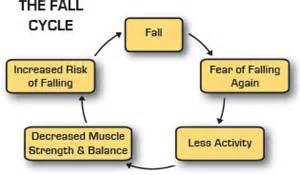Humpty Dumpty sat on a wall…Humpty Dumpty had a great fall. While we all know the famous story of Humpty Dumpty, we might not consider a fall being a great thing. Just as in the story where none of the King’s horses or King’s men could put Humpty back together again, sometimes we cannot be put back together again.
As part of Falls Prevention month, it is important to recognize that there are myths, cycles and prevention measures that surround falls.
Myths vs. Reality
First five myths that the National Coalition on Aging (2013) helps us to debunk:
As long as I stay at home, I can avoid falling.
Over half of all falls take place at home. Inspect your home for fall risks. Fix simple but serious hazards such as clutter, throw rugs, and poor lighting. Make simple home modifications, such as adding grab bars in the bathroom, a second handrail on stairs, and non-slip paint on outdoor steps.
Taking medication does not increase my risk of falling.
Taking any medication may increase your risk of falling. Medications affect people in many different ways and can sometimes make you dizzy or sleepy. Be careful when starting a new medication. Talk to your health care provider about potential side effects or interactions of your medications.
I do not need to get my vision checked every year.
Vision is another key risk factor for falls. Aging is associated with some forms of vision loss that increase risk of falling and injury. People with vision problems are more than twice as likely to fall as those without visual impairment. Have your eyes checked at least once a year and update your eyeglasses. For those with low vision there are programs and assistive devices that can help. Ask your optometrist for a referral.
Let's talk about the fall cycle...

After a person sustains their first fall (serious or minor), a fear of falling can develop. If we do not move, the risk of falling (in theory) decreases, because we are moving less. Unfortunately, by moving less, we also decrease our strength and balance and thus, the risk of falling grows.
Some people believe that the best way to prevent falls is to stay at home and limit activity. This is simply not true. Performing physical activities will actually help you stay independent, as your strength and range of motion benefit from remaining active. Social activities are also good for your overall health. While we do lose muscle as we age, exercise can partially restore strength and flexibility. It is never too late to start an exercise program. Even if you have been a “couch potato” your whole life, becoming active now will benefit you in many ways—including protection from falls.
Now on to prevention tips...
First, ask the doctor or pharmacist to review all medications both over the counter and prescribed. Next, see a health care provider regularly for chronic conditions such as Parkinson’s disease, history of stroke, arthritis and visual impairment. See an eye doctor for a vision check at least once a year to ensure you have the correct prescription and if anything new has developed, the physician can treat it. Having a safe environment is also key to falls prevention. Remove tripping hazards such as throw rugs and clutter in walkways.
- Use non-slip mats in the bathtub and on shower floors.
- Have grab bars put next to the toilet and in the tub or shower.
- Have handrails put in on both sides of stairways.
- Improve lighting throughout the home.
- Increase lower body strength and improve balance through regular physical activity.
Now, let us think back to Humpty Dumpty, perhaps if he had read this blog, his story might have gone like this…
Humpty dumpty took a walk, while seeing the wall, he decided today was not a good day to go and sit. His balance had been off and though he had been practicing his strength and balance exercises, he was not quite ready to climb back up. When all of the King’s horses and all of King’s men came by they were surprised to see Humpty in one piece! Humpty shared that he had recently had his eyes checked and that his physician was adjusting his medications to decrease his risk of falls. Humpty shared that by seeing the sights of town while walking, instead of sitting up on the wall, that he was decreasing his risk of falls. Humpty dumpty continued on his walk and we hope that you will, too!
Blog provided by
Kelly Llewellyn, MSN, RN
Injury Prevention/EMS Specialist at Meritus Health
Safe Kids Washington County Co-Coordiator
Reference
National Coalition on Aging. (2016) Debunking the myths of older adult falls. https://www.ncoa.org/article/debunking-the-myths-of-older-adult-falls


